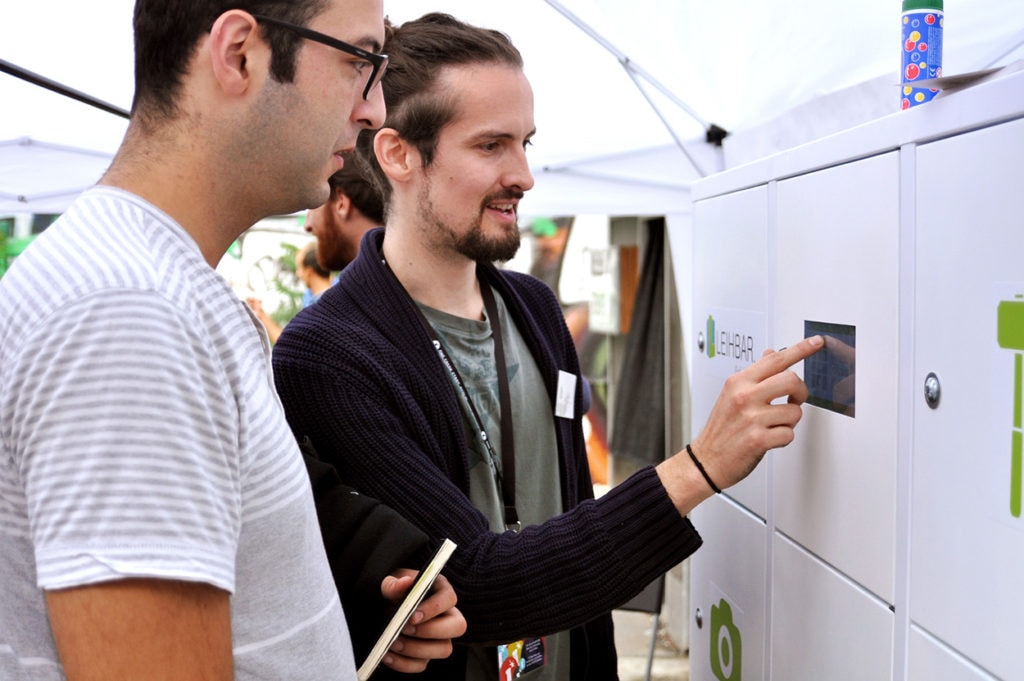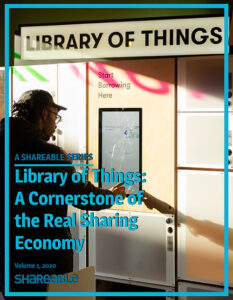Expensive, hard to transport and long-lived compared with other consumer goods, tools are a good model for the sharing economy. But how do you keep tools functioning in an era of built-in obsolescence, and how can you keep a lid on staff and storage costs when the library model depends heavily on both? Shareable connected with a Berlin-based sharing project that aims to get affordable tools into the hands of renters, who generally could not afford to buy them.
Leihbar (‘shareable’ in German), a Berlin item-sharing project, began in the 2012 peer-to-peer sharing platform boom as a way for people with underused items to loan them to those who needed them but soon iterated multiple times, looking for a sustainable business model.
At the start, the goal seemed simple for Leihbar: People already have a lot of things and most of them are underused. So it’s just a matter of reallocation, right? But conversations with existing p2p lending players and users revealed two structural weaknesses: Supply and demand do not match, and the lending process takes time that busy people do not have.
Suppliers mostly offer low-priced items or things they don’t use anymore, like books and DVDs instead of high-value products like projectors, video equipment and tents. Even if you find the item you’re looking for, its quality, usability, or the rental window often won’t suit your needs.
The biggest obstacle to p2p lending, however, is time. Unless you are willing to spend the time to search, pick up and return items to the same place, it is much more convenient to buy the item instead. P2p platforms discovered that for their schemes to work, access should not cost more than a few minutes and should be easily integrated into the busy lives of all participants.
The next approach for Leihbar was a b2c-approach, operating a store in a downtown coworking space. Users could rent high-quality consumer electronics, outdoor gear and tools. For its nine months of operation, customer response remained sluggish but it did show a trend: The closer people lived to the shop, the more likely they were to rent. Ultimately, the store folded due to the high costs of staff, marketing and rent.
Another iteration of the project was to create that hyper-local market with lower overheads, so Leihbar turned to an automated lending-locker. But a one-year prototype with an automated lending-locker in a student accommodation with 700 students showed small demand and it seemed like the company had built the infrastructure for a massive p2p and b2c sharing scheme without considering individual user journeys. Engineering had blocked their view from anthropocentric design.
So the final iteration was to strip the business back to a b2c booking website in cooperation with convenience stores, which doubled as exchange locations 24/7. The stores got a cut of the transaction fees, and the staff was able to pivot easily to distributing loaned goods because they were used to handling parcels.
The business tackled the time-poor problem by creating an amiable fee structure and locating in stores that were already close to customers’ homes. It was easy for users to integrate pick-up and drop-off visits into their busy lives. Over six months, revenues and usage rose to cover the cost of best-sellers like projectors and steam cleaners, which paid for themselves over three to six months. However, overcoming those challenges uncovered others. What the company thought were logistical problems turned out to be a marketing challenge. Despite marketing their full product portfolio, return customers would only rent a single item.

Ultimately, this model also failed. The proliferation of items in nearly every home creates a multitude of sharing-micro-markets instead of one sharing macro-market. People are still too accustomed to owning things of their own. Leihbar didn’t succeed in solving the key marketing questions: How to promote the idea of using instead of owning items of everyday use in the most cost-effective way? How to get recurring customers and create a portfolio effect?
Leihbar’s vision was clear from the beginning: To create an ecosystem that would change the way things were produced. The ultimate goal was delivering a blueprint for a circular economy for items of daily use. The impact of p2p sharing platforms turned out to be fostering social contact between strangers, Leihbar looked for ways to incentivize producers to shift the supply side towards a circular model. Leihbar cooperated with tool manufacturer Bosch, and Dyson, a vacuum cleaner maker. They wanted to prove the case that it is more economically viable to amortize the products by renting them over the course of a couple of months instead of selling them once every two years. It was hoped that manufacturers would understand the value and shift to modular, repairable and long-lasting products. But the response was instead to use the sharing economy as a marketing tool for increased sales. A model of durable, repairable and producer-recycled items seems incompatible with the prevailing growth-centered company culture.
So, what is the path forward? One option is to create a co-op of users, tool producers and local administrations, where borrowers pay a subscription fee that is heavily subsidized by local governments to fulfill environmental goals and create cleaner cities. The co-ops can act as laboratories for producers to design durable, repairable, maintainable and recyclable products. If producers refuse to shift or expand their business model, local manufacturing cooperatives would need to start producing new items.
The other future is an extension of our present, with producers creating direct relationships with customers and flooding cities with products in an uncoordinated way — much like the bicycle or scooter sharing systems that are choking our cities. Customers already accustomed to receiving a constant stream of Amazon packages to their homes would embrace online ordering and swift delivery for rental items too. As the drone delivery bots darken the skies, we would have traded out a shareable, sustainable, environmentally responsible future — for convenience.
##
 |
This post is part of our 2020 editorial series on libraries of things. Download the free ebook from the series here. |









